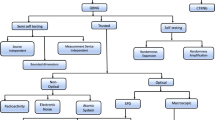Abstract
It is shown that the bounds on the expected running times of most of the randomized incremental algorithms in computational geometry do not change by more than a constant factor when they are made pseudorandom using a very simple scheme. This reduces the number of random bits used by these algorithms from Ω(nlogn) toO(logn).
Similar content being viewed by others
References
N. Alon, O. Goldreich, J. Hastad, R. Perelta, Simple constructions of almostk-wise independent random variables,Proc. of the 31st Annual IEEE Symp. on Foundations of Computer Science, 1990, pp. 544–553.
J. Boissonnat, O. Devillers, R. Schott, M. Teillaud, M. Yvinec, Applications of random sampling to on-line algorithms in computational geometry,Discrete Comput. Geom., 8:51–71, 1992.
B. Chazelle, An optimal convex hull algorithm and new results on cuttings,Proc. of the 32nd Annual IEEE Symp. on Foundations of Compter Science, 1991, pp. 29–38.
B. Chazelle, H. Edelsbrunner, An optimal algorithm for intersecting line segments in the plane,J. Assoc. Comput. Mach., 39:1–54, 1992.
B. Chazelle, J. Friedman, A deterministic view of random sampling and its use in geometry,Combinatorica, 10(3):229–249, 1990.
B. Chazelle, J. Matoušek, On linear-time deterministic algorithms for optimization problems in fixed dimension,Proc. of the 4th ACM Symp. on Discrete Algebra, 1993.
K. Clarkson, P. Shor, Applications of random sampling in computational geometry, II,Discrete Comput. Geom., 4:387–421, 1989.
L. Guibas, D. Knuth, M. Sharir, Randomized incremental construction of Delauney and Voronoi diagrams,Algorithmica, 7:381–413, 1992.
D. Haussler, E. Welzl, Epsilon-nets and simplex range queries,Discrete Comput. Geom., 2:127–151, 1987.
H. Karloff, P. Raghavan, Randomized algorithms and pseudorandom numbers,Proc. of the 20th Annual ACM Symp. on Theory of Computing, 1988, pp. 310–321.
M. Luby, A simple parallel algorithm for the maximal independent set problem,SIAM J. Comput., 15:1036–1053, 1986.
N. Megiddo, Linear programming in linear time when the dimension is fixed,J. Assoc. Comput. Mach., 34:114–127, 1981.
K. Mehlhorn, S. Meiser, C. O'Dunlaing, On the construction of abstract Voronoi diagrams,Discrete Comput. Geom., 6:211–224, 1991.
K. Mulmuley,Computational Geometry: An Introduction Through Randomized Algorithms, Prentice-Hall, Englewood Cliffs, NJ, 1994.
K. Mulmuley, A fast planar partition algorithm, I,Proc. of the 29th Annual IEEE Symp. on Foundations of Computer Science, 1988, pp. 580–589.
K. Mulmuley, An efficient algorithm for hidden surface removal (Proc. of the ACM SIGGKAPH),Comput. Graphics, 23(3):379–388, 1989.
K. Mulmuley, On levels in arrangements and Voronoi diagrams,Discrete Comput. Geom., 6:307–338, 1991.
K. Mulmuley, Randomized multidimensional search trees: lazy balancing and dynamic shuffling,Proc. of the 32nd Annual IEEE Symp. on Foundations of Computer Science, 1991, pp. 180–196.
J. Naor, M. Naor, Small bias probability spaces: efficient constructions and applications,Proc. of the 22nd Annual ACM Symp. on Theory of Computing, 1990, pp. 213–223.
J. Reif, S. Sen, Optimal parallel randomized algorithms for 3-D convex hulls and related problems. Manuscript, preliminary version appears as “Polling: a new randomized sampling technique for computational geometry” inProc. of the 21st Annual ACM Symp. on Theory of Computing, 1989, pp. 394–404.
O. Schwarzkopf, Dynamic maintenance of geometric structures made easy,Proc. of the 32nd Annual IEEE Symp. on Foundations of Computer Science, 1991, pp. 197–206.
R. Seidel, Low dimensional linear programming and convex hulls made easy,Discrete Comput. Geom., 6:423–434, 1991.
R. Seidel, A simple and fast incremental randomized algorithm for computing trapezoidal decompositions and for triangulating polygons.Comput. Geom. Theory Appl, 1:51–64, 1991.
R. Seidel, Backward analysis of randomized incremental algorithms,New Trends in Discrete and Computational Geometry (J. Pach ed.), Springer-Verlag, New York, 1993, pp. 37–67.
J. Spencer,Ten Lectures on the Probabilistic Method, CBMS-NSF, SIAM, Philadelphia, PA, 1987.
Author information
Authors and Affiliations
Additional information
Communicated by M. Luby.
This research was supported by Packard fellowship.
Rights and permissions
About this article
Cite this article
Mulmuley, K. Randomized geometric algorithms and pseudorandom generators. Algorithmica 16, 450–463 (1996). https://doi.org/10.1007/BF01940875
Received:
Revised:
Issue Date:
DOI: https://doi.org/10.1007/BF01940875




